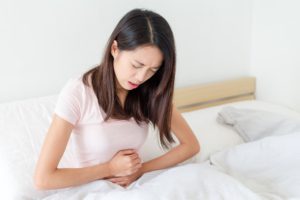Primary Dysmenorrhea – Period Pain of Unknown Cause
In this article, we will provide a comprehensive understanding of primary dysmenorrhea. We will clarify the term, delve into when primary dysmenorrhea typically occurs, outline its characteristic symptoms, and explore potential risk factors. Additionally, we will investigate possible causes and shed light on its connection with endometriosis.
While the term “primary dysmenorrhea” may seem complex initially, a closer examination reveals the medical root “menorrhea.” This term originates from Greek (mḗn=month and rhoḗ=the flow, the flowing) and pertains to menstruation [1], [2]
Conditions or symptoms containing the term “menorrhea” are linked to menstrual bleeding. For instance, “hypermenorrhea” denotes excessively heavy (hyper) menstrual bleeding, while “dysmenorrhea” refers explicitly to period pain.

Dysmenorrhea describes the symptoms of menstrual pain.
What sets apart primary and secondary dysmenorrhea?
Dysmenorrhea is the term used to describe the symptoms of menstrual pain. Adding “primary” or “secondary” clarifies these symptoms’ origin. In cases of primary dysmenorrhea, the menstrual pain is considered the clinical picture or disease name itself because there are no other known causes. On the other hand, secondary dysmenorrhea indicates the symptom is a result of an underlying condition, such as endometriosis, adenomyosis, leiomyomas (benign uterine tumors), or chronic pelvic inflammatory diseases (PIDs) [4], [5], [16].
In endometriosis, secondary dysmenorrhea emerges as a symptom because the pain is attributed to endometriosis or adenomyosis lesions.
In primary dysmenorrhea, the precise cause is unknown. However, it is essential to emphasize that the symptoms are not imagined but associated with menstruation and not another underlying condition. This means that even healthy women can experience primary dysmenorrhea, which most women encounter at some point in their lives. Nevertheless, it is not something to endure but to address and manage effectively.
When does primary dysmenorrhea typically occur?
Primary dysmenorrhea is far more prevalent than its secondary counterpart. Regrettably, it is often overlooked, undiagnosed, and inadequately addressed. Part of the reason for this oversight is the social tendency to downplay period pain and consider it a normal part of life, discouraging women with discomfort from seeking medical attention. However, it is essential to note that more than half of all women experience primary dysmenorrhea, at least intermittently, during their lifetime, and this should not be considered the norm.
Younger women are particularly susceptible, with approximately 70-90% of women under 24 years old experiencing primary dysmenorrhea [6], [7], [8]. Menstrual cramps often lead to significant disruptions in the daily lives of affected women. They can severely impact their quality of life in the days leading up to and during menstruation. Approximately 2 to 29% of menstruating women endure severe pain in the form of primary dysmenorrhea. Consequently, it can be a frequent cause of work or school absences. Furthermore, menstruation remains a topic shrouded in taboos, leading many women to endure the pain silently. Therefore, doctors also share responsibility for diagnosis, education, treatment options, and challenging societal taboos in this context [9], [10].
What are the symptoms of primary dysmenorrhea?
In primary dysmenorrhea, the characteristic symptoms typically manifest 1 to 3 days before the onset of menstruation, peaking about 24 hours after the menstruation begins. This discomfort generally persists for up to 3 days and is commonly described as a sharp, stabbing pain. Additionally, individuals may experience cramping, a dull or throbbing continuous ache. While menstrual pain usually originates in the abdomen, it can sometimes radiate to the legs and back. Less frequently, individuals may also encounter accompanying symptoms such as nausea, vomiting, diarrhea, constipation, frequent urination, headaches, and a general feeling of malaise [5], [11], [12].
Complaints related to primary dysmenorrhea predominantly emerge within the first 6 to 24 months following the onset of the first menstruation, primarily affecting younger women. Hence, early information and awareness about this condition are crucial. Typically, as women age, the pain diminishes or even disappears entirely. Additionally, the birth of a child can also promote a reduction in primary dysmenorrhea symptoms [5], [12], [13].
It is essential to differentiate primary dysmenorrhea symptoms from those of premenstrual syndrome (PMS). Unlike primary dysmenorrhea, PMS symptoms typically appear before menstruation and subside with the onset of the period. PMS symptoms vary among individuals and result from hormonal fluctuations. These symptoms encompass a range of mental and physical complaints, including mood swings and breast tenderness [21], [22].

High coffee consumption, lack of exercise, and stress, among other factors, can contribute to developing primary dysmenorrhea.
What are the known causes?
A metastudy published in 2022 comprehensively assessed and summarized the risk factors associated with primary dysmenorrhea. The following factors have been identified as significant contributors to the development of primary dysmenorrhea [5], [14], [15], [16]:
- Early onset of menstruation
- Long, heavy, acyclic menstruation
- Smoking, alcohol consumption, and heavy caffeine intake
- Age younger than 20 years
- Positive family history for dysmenorrhea
- Particularly high or low BMI values
- Low intake of omega-3 fatty acids
- Physical inactivity
- Retroflexed uterus (uterus tilted backward) and narrow cervix
- Irregular or skipped meals
Various influencing factors have been observed, including sleep disturbances, poor sleep quality, elevated stress levels, anxiety, and depression. These variables have also shown a higher prevalence among women with primary dysmenorrhea in scientific studies [5], [17], [18], [19].
What is the role of prostanoids in primary dysmenorrhea?
As of now, the exact cause (pathophysiology) of primary dysmenorrhea remains not fully elucidated. However, current research has focused on a specific group of signaling molecules known as prostanoids. Prostanoids play a pivotal role in mediating inflammatory and pain responses in the human body. This group includes substances like prostaglandins, prostacyclin, and thromboxanes. Typically, these signaling molecules facilitate uterine muscle contractions and the expulsion of endometrial tissue, enabling menstrual bleeding.
In the context of primary dysmenorrhea, current understanding suggests that excessive prostanoids are produced by endometrial cells during menstruation and are released into the menstrual blood. These elevated levels lead to intense contractions of the uterine muscle layer, causing constriction of blood vessels. Consequently, this reduced blood flow (ischemia) heightens nerve sensitivity, increasing pain. This process also contributes to inflammatory reactions and the development of severe menstrual cramps [5], [14], [20], [21].
Current research findings regarding prostanoids are promising and indicate that women with primary dysmenorrhea have elevated prostaglandin levels. However, the extent of prostanoids’ involvement in the condition is still under investigation, and further research is required to comprehend their role fully. As new insights emerge, we will continue to provide updates on this topic!
What role does endometriosis play in this context?
Like primary dysmenorrhea, endometriosis also results in severe pain and discomfort for individuals affected by it. The wide range of symptoms associated with endometriosis can make it challenging to pinpoint the cause of the complaints. Consequently, there is a possibility that symptoms attributed to primary dysmenorrhea may stem from other, organic causes. For example, endometriosis and adenomyosis are occasionally misdiagnosed as primary dysmenorrhea, potentially preventing affected individuals from receiving the appropriate treatment. Therefore, those experiencing these symptoms must take them seriously and seek clarification from a knowledgeable doctor [4].
Conclusion
Primary dysmenorrhea is a prevalent condition characterized by menstrual pain, predominantly affecting younger women. Typical symptoms include stabbing and cramping abdominal pain. Factors like irregular menstruation, stress, and sleep disturbances exacerbate primary dysmenorrhea. Ongoing research is exploring the role of prostanoids in this condition.
Emerging findings suggest a significant link between elevated prostaglandin levels and primary dysmenorrhea. Given that organic causes, including endometriosis, can also underlie its symptoms, it is essential to seek medical evaluation for persistent pain.
References
- Educalingo. Etymologie des Wortes Menorrhoe. https://educalingo.com/de/dic-de/menorrho. Accessed 24 April, 2023.
- Ovularing. Zyklusstörungen erkennen. https://ovularing.com/der-weibliche-zyklus/zyklusstoerungen/. Accessed 24 April, 2023.
- Walter F, Antwerpes F, Fink B et al. Doc Check Flexikon. Menstruation. https://flexikon.doccheck.com/de/Menstruation. Accessed 24 April, 2023.
- Antwerpes F, Ekert D, Graf von Westphalen G et al. Doc Check Flexikon. Dysmenorrhoe. https://flexikon.doccheck.com/de/Dysmenorrhö. Accessed 24 April, 2023.
- Pinkerton J. University of Virginia Health System. MSD Manual. Dysmenorrhoe. https://www.msdmanuals.com/de/profi/gynäkologie-und-geburtshilfe/menstruationsstörungen/dysmenorrhoe. Accessed 24 April, 2023.
- Mendiratta V, Lentz GM. In: Comprehensive gynecology. 7th ed. Lobo RA, Gershenson DM, Lentz GM, editors. Philadelphia (PA): Elsevier Inc; 2017. Primary and secondary dysmenorrhea, premenstrual syndrome, and premenstrual dysphoric disorder; pp. 815–28. https://www.ncbi.nlm.nih.gov/pmc/articles/PMC8943241/. Accessed 26 April, 2023.
- Bernardi M, Lazzeri L, Perelli F, Reis FM, Petraglia F. Dysmenorrhea and related disorders. F1000Res. 2017;6:1645. https://pubmed.ncbi.nlm.nih.gov/28944048/. Accessed 26 April, 2023.
- Ju H, Jones M, Mishra G. The prevalence and risk factors of dysmenorrhea. Epidemiol Rev. 2014;36:104–13. https://pubmed.ncbi.nlm.nih.gov/24284871/. Accessed 26 April, 2023.
- Iacovides S, Avidon I, Baker FC. What we know about primary dysmenorrhea today: a critical review. Hum Reprod Update. 2015;21:762–78. https://pubmed.ncbi.nlm.nih.gov/26346058/. Accessed 26 April, 2023.
- Chen L, Tang L, Guo S, Kaminga AC, Xu H. Primary dysmenorrhea and self-care strategies among Chinese college girls: a cross-sectional study. BMJ Open. 2019;9:e026813. https://pubmed.ncbi.nlm.nih.gov/31537555/. Accessed 26 April, 2023.
- Sharghi M, Mansurkhani SM, Larky DA, Kooti W, Niksefat M, Firoozbakht M, et al. An update and systematic review on the treatment of primary dysmenorrhea. JBRA Assist Reprod. 2019;23:51–7. https://pubmed.ncbi.nlm.nih.gov/30521155/. Accessed 26 April, 2023.
- Techniker Krankenkasse. Institut für Qualität und Wirtschaftlichkeit im Gesundheitswesen. Regelschmerzen (Dysmenorrhoe). https://www.tk.de/techniker/gesundheit-und-medizin/behandlungen-und-medizin/gynaekologische-und-urologische-erkrankungen/regelschmerzen-dysmenorrhoe-2017308?tkcm=ab. Accessed 26 April, 2023.
- Proctor ML, Farquhar CM. Dysmenorrhoea. BMJ Clin Evid. 2007;2007:0813. https://pubmed.ncbi.nlm.nih.gov/19454059/. Accessed 26 April, 2023.
- Itani R, Soubra L, Karout S, Rahme D, Karout L, Khojah HMJ. Primary Dysmenorrhea: Pathophysiology, Diagnosis, and Treatment Updates. Korean J Fam Med. 2022 Mar;43(2):101-108. doi: 10.4082/kjfm.21.0103. Epub 2022 Mar 17. PMID: 35320895; PMCID: PMC8943241. https://www.ncbi.nlm.nih.gov/pmc/articles/PMC8943241/. Accessed 25 April, 2023.
- Duman NB, Yıldırım F, Vural G. Risk factors for primary dysmenorrhea and the effect of complementary and alternative treatment methods: Sample from Corum, Turkey. Int J Health Sci (Qassim). 2022 May-Jun;16(3):35-43. PMID: 35599944; PMCID: PMC9092532. https://www.ncbi.nlm.nih.gov/pmc/articles/PMC9092532/#:~:text=Risk%20factors%20for%20PD%20are,intake%2C%20tobacco%20and%20alcohol%20use%2C. Accessed 25 April, 2023.
- Liwen Wang, Yuhan Yan, Huiyu Qiu, Datong Xu, Jiaqi Zhu, Jing Liu, Hui Li. Prevalence and Risk Factors of Primary Dysmenorrhea in Students: A Meta-Analysis. Value in Health. Volume 25, Issue 10. 2022. Pages 1678-1684. ISSN 1098-3015. https://www.sciencedirect.com/science/article/abs/pii/S1098301522001929. Accessed 26 April, 2023.
- Türkmen H. Üniversite öğrencilerinde dismenore görülme sıklığıve dismenoreye etki eden faktörler. CBU SBED. 2019;6:39–46. https://www.researchgate.net/publication/360824158_Risk_factors_for_primary_dysmenorrhea_and_the_effect_of_complementary_and_alternative_treatment_methods_Sample_from_Corum_Turkey. Accessed 26 April, 2023.
- Fernández-Martínez E, Onieva-Zafra MD, Parra-Fernández ML. Lifestyle and prevalence of dysmenorrhea among Spanish female university students. PLoS One. 2018;13:e0201894. https://www.ncbi.nlm.nih.gov/pmc/articles/PMC6086430/. Accessed 26 April, 2023.
- Orhan C, Çelenay ŞT, Demirtürk F, Özgül S, Üzelpasacı E, Akbayrak T. Effects of menstrual pain on the academic performance and participation in sports and social activities in Turkish university students with primary dysmenorrhea:A case control study. J Obstet Gynaecol Res. 2018;44:2101–9. https://pubmed.ncbi.nlm.nih.gov/30043399/. Accessed 26 April, 2023.
- Irmasanti Fajrin, Gemini Alam, Andi Nilawati Usman. Prostaglandin level of primary dysmenorrhea pain sufferers. Enfermería Clínica. Volume 30, Supplement 2. 2020. Pages 5-9. ISSN 1130-8621. https://www.sciencedirect.com/science/article/pii/S1130862119303158. Accessed 26 April, 2023.
- Endometriose-App. Prämenstruelles Syndrom. https://endometriose.app/was-in-deinem-koerper-eine-woche-vor-der-periode-geschieht-das-praemenstruelle-syndrom-pms/. Accessed 9 May, 2023.
- MSD Manuals. Ausgabe für Patienten. Prämenstruelles Syndrom. https://www.msdmanuals.com/de-de/heim/gesundheitsprobleme-von-frauen/menstruationsstörungen-und-abnormale-scheidenblutungen/prämenstruelles-syndrom-pms#:~:text=PMS%20umfasst%20jede%20Kombination%20der,Frau%20gewöhnlich%20täglich%20festgestellt%20werden. Accessed 9 May, 2023.
You can now track your daily well-being using the Endo-App.
Click on the button below to download the app, now available for free to those affected by endometriosis.
Do you also suffer from severe period pain? Feel free to share your report with us!
- Investigating the Effects of Green Tea Complex or Extract on Pain and Mucosal Health - 1. October 2023
- Understanding Primary Dysmenorrhea: Causes, Symptoms, and Treatment - 26. September 2023
- Why is Endometriosis So Often Mistaken for Chlamydia? - 2. September 2023
